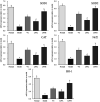Effect of lemon peel flavonoids on UVB-induced skin damage in mice
- PMID: 35520688
- PMCID: PMC9056540
- DOI: 10.1039/d0ra05518b
Effect of lemon peel flavonoids on UVB-induced skin damage in mice
Abstract
By establishing an effective ultraviolet B (UVB) radiation model of skin damage in mice, the effect of lemon peel flavonoids (LPF) on skin damage was explored. UVB skin damage in UV-irradiated mice was simulated, and animal models were established. Serum parameters were measured using kits, skin sections were stained with hematoxylin-eosin (H&E) and Masson, and quantitative polymerase chain reaction (qPCR) was used to detect the expression of skin tissue-related mRNA. The experimental results showed that LPF increased the activity of catalase (CAT) and superoxide dismutase (SOD) oxidases in serum of mice with UVB-induced skin damage and decreased MDA, interleukin-1β (IL-1β), IL-6, IL-10, and tumor necrosis factor-alpha (TNF-α) levels. Pathological observation indicated that LPF alleviated the skin tissue lesions caused by UVB. LPF upregulated the mRNA expression of SOD1, SOD2, CAT, nuclear factor erythroid-2 related factor 2 (Nrf2), heme oxygenase-1 (HO-1), and inhibitor of NF-κB alpha (IκB-α) and downregulated the expression of nuclear factor kappa B (NF-κB), p38 MAPK, and cyclooxygenase-2 (COX-2) in the skin tissue of skin-damaged mice. There was a greater protective effect of LPF on the skin as compared to vitamin C (VC) at the same application concentration, and the effect of LPF was positively correlated with the concentration. High performance liquid chromatography (HPLC) analysis showed that LPF contained five flavonoid compounds, namely isomangiferin, rutin, astragalin, naringin, and quercetin. We demonstrated that flavonoids from LPF exhibit an excellent skin protection effect with satisfactory application value.
This journal is © The Royal Society of Chemistry.
Conflict of interest statement
No conflicts of interest in this article.
Figures





Similar articles
-
Trans-chalcone added in topical formulation inhibits skin inflammation and oxidative stress in a model of ultraviolet B radiation skin damage in hairless mice.J Photochem Photobiol B. 2017 Jun;171:139-146. doi: 10.1016/j.jphotobiol.2017.05.002. Epub 2017 May 2. J Photochem Photobiol B. 2017. PMID: 28501692
-
Protective Effect of Lemon Peel Extract on Oxidative Stress in H9c2 Rat Heart Cell Injury.Drug Des Devel Ther. 2021 May 14;15:2047-2058. doi: 10.2147/DDDT.S304624. eCollection 2021. Drug Des Devel Ther. 2021. PMID: 34017169 Free PMC article.
-
A novel type lavandulyl flavonoid from Sophora flavescens as potential anti-hepatic injury agent that inhibit TLR2/NF-κB signaling pathway.J Ethnopharmacol. 2023 May 10;307:116163. doi: 10.1016/j.jep.2023.116163. Epub 2023 Feb 2. J Ethnopharmacol. 2023. PMID: 36738945
-
Preventive Effect of Flavonoid Extract from the Peel of Gonggan (Citrus reticulata Blanco Var. Gonggan) on CCl4-Induced Acute Liver Injury in Mice.J Inflamm Res. 2021 Oct 5;14:5111-5121. doi: 10.2147/JIR.S332134. eCollection 2021. J Inflamm Res. 2021. PMID: 34675591 Free PMC article.
-
[Mechanism of Tibetan medicine Ershiwuwei Songshi Pills against liver injury induced by acetaminophen in mice based on Keap1/Nrf2 and TLR4/NF-κB p65 signaling pathways].Zhongguo Zhong Yao Za Zhi. 2022 Apr;47(8):2049-2055. doi: 10.19540/j.cnki.cjcmm.20211103.707. Zhongguo Zhong Yao Za Zhi. 2022. PMID: 35531720 Chinese.
Cited by
-
Extremophilic Solutions: The Role of Deinoxanthin in Counteracting UV-Induced Skin Harm.Curr Issues Mol Biol. 2023 Oct 16;45(10):8372-8394. doi: 10.3390/cimb45100528. Curr Issues Mol Biol. 2023. PMID: 37886971 Free PMC article.
-
A Scoping Review on the Effects of Carotenoids and Flavonoids on Skin Damage Due to Ultraviolet Radiation.Nutrients. 2022 Dec 24;15(1):92. doi: 10.3390/nu15010092. Nutrients. 2022. PMID: 36615749 Free PMC article.
References
-
- Huang Y. Tu X. L. Ma X. L. Wang J. Lv X. L. Sci. Technol. Food Ind. 2019;40:83–88.
LinkOut - more resources
Full Text Sources
Research Materials
Miscellaneous

